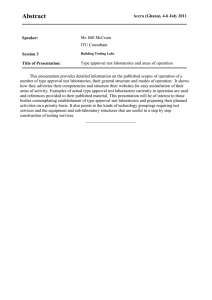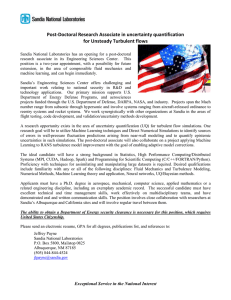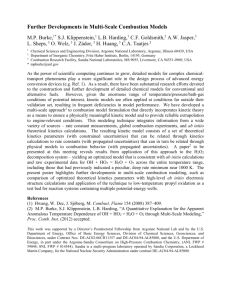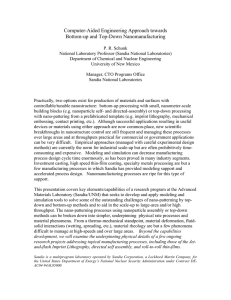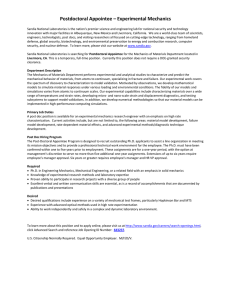One-Dimensional Stochastic Simulation of Turbulence-Microscale Interactions Alan Kerstein Combustion Research Facility
advertisement
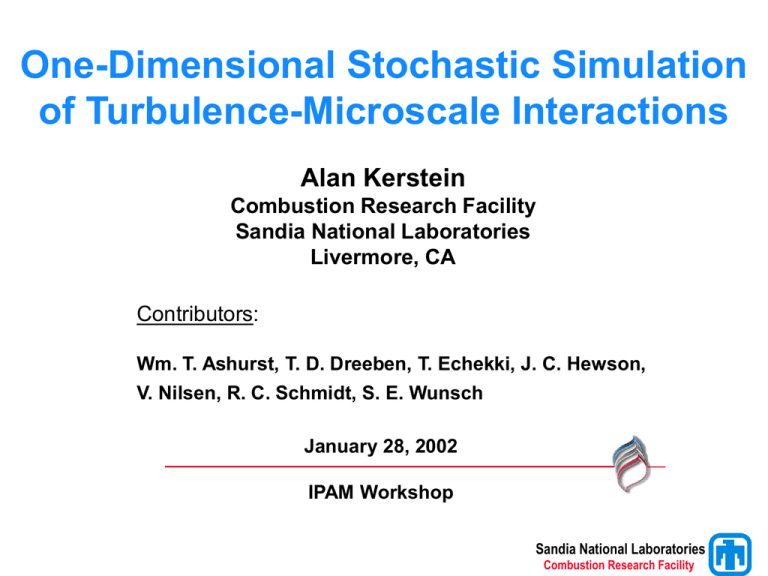
One-Dimensional Stochastic Simulation of Turbulence-Microscale Interactions Alan Kerstein Combustion Research Facility Sandia National Laboratories Livermore, CA Contributors: Wm. T. Ashurst, T. D. Dreeben, T. Echekki, J. C. Hewson, V. Nilsen, R. C. Schmidt, S. E. Wunsch January 28, 2002 IPAM Workshop Sandia National Laboratories Combustion Research Facility Outline of presentation One-dimensional models of turbulence, past and present Overview of the present approach Representative applications – Planar mixing layers – Buoyant stratified flows – Combustion Near-wall momentum closure for large-eddy simulation (LES) A bottom-up approach to multidimensional turbulent flow simulation Conclusions Sandia National Laboratories Combustion Research Facility Use of the boundary layer approximation and the mixing length hypothesis in turbulence models Example: temporal planar boundary layer Laminar: y Re UL / ut u yy L(t ) Turbulent ( Re 1): ut e u yy Mixing length hypothesis: e ( y) ~ y 2 / where u (0, t ) U 1/ ~ u y Quasisteady assumption: Lateral momentum flux e u y is independent of 2 2 Then y u y constant, giving u ~ log y U y in some y range Limitations: Describes mean flow Parameterization of e is flow dependent Advection is modeled as diffusion, affecting the realism of couplings to microphysics Sandia National Laboratories Combustion Research Facility The mixing length concept is not inherently restricted to average behavior ‘Typical’ eddy at height y: u( y2 , t ) y y u ( y1, t ) This picture motivates a time-resolved 1D model involving a sequence of fluid displacements Sandia National Laboratories Combustion Research Facility A time resolved formulation can have a range of eddy sizes crossing a given height Why include all eddies? Averaged models sometimes allow for more than one eddy size, e.g., ‘inactive’ (large) eddies in boundary layers Desire an eddy population governed by the ICs and BCs (rather than flow specific parametric assumptions) y Resolve small eddies to obtain realistic advective-diffusive coupling, e.g., – viscous wall layer – diffusive interfaces in buoyant flows – thin flames in turbulent combustion Sandia National Laboratories Combustion Research Facility Goals Predict or explain properties of flows such as – Wall boundary layers – Planar shear flows (mixing layers, jets) – Horizontally homogeneous buoyant stratified flows (e.g., many geophysical flows) – Cylindrically and spherically homogeneous flows (pipe flow, stellar convection) Develop improved subgrid-scale (SGS) models for 3D simulations (e.g., LES) Sandia National Laboratories Combustion Research Facility A new modeling approach: One-Dimensional Turbulence Molecular evolution based on a boundary layer formulation is supplemented by an ‘eddy process,’ e.g., ut u yy eddies To specify the eddy process, need Definition of an eddy (biography) Eddy selection procedure (demography) Sandia National Laboratories Combustion Research Facility 1D eddy implementation involves two steps Kinematics: Lateral fluid displacements with properties (velocity, etc.) unchanged within fluid elements Dynamics: Modification of velocity profiles within the eddy to reflect conversion between kinetic and gravitational potential energy energy exchange among velocity components (pressure scrambling) Sandia National Laboratories Combustion Research Facility The triplet map is a 1D procedure TRIPLET MAP: A "SHELL GAME" that emulates 3D eddy kinematics TRIPLET MAP The triplet map captures compressive strain and rotational folding effects, and causes no property discontinuities c(x) The triplet map is implemented numerically as a permutation of fluid cells c(x) x This procedure emulates the effect of a 3D eddy on property profiles along a line of sight c(x) x Sandia National Laboratories Combustion Research Facility The triplet map transports momentum laterally and amplifies shear High shear at small scales drives small eddies, leading to an eddy cascade Sandia National Laboratories Combustion Research Facility Eddy dynamics Wavelets are added to velocity profiles within an eddy to change kinetic energy components while satisfying conservation laws Wavelets measure or modify fluctuations on a particular scale (e.g., the eddy size). Unlike Fourier transforms, wavelets are applied locally (e.g., to an eddy) rather than globally. Sandia National Laboratories Combustion Research Facility An eddy event event consists of a triplet map followed by velocity profile changes 20 20 u v w c 15 15 10 Triplet map is applied to all properties (velocities u, v, w and scalar, c) 5 0 -5 5 0 -5 -10 5 10 y 0 20 15 5 10 15 20 20 15 Dynamic step affects velocities but not scalar 10 u, v, w, c -10 0 eddy range u, v, w, c u, v, w, c 10 5 0 -5 -10 0 5 10 15 20 Sandia National Laboratories Combustion Research Facility Eddy selection procedure Assign a time scale to each possible eddy, parameterized by eddy size and location within the computational domain The set of values defines an eddy rate distribution l from which eddies are sampled The physics is in the determination of (as in mixing length theory) Sandia National Laboratories Combustion Research Facility Determination of (schematic) Principle: Enforce consistency of eddies and flow (velocity and density profiles) Eddy: Eddy velocity ~ l / so eddy energy ~ l 3 / 2 ( l eddy size) Flow: P gravitational potential energy change caused by eddy K maximum kinetic energy extractable by adding wavelets to velocity components Relation determining : l3 2 A K P Z l 2 adjustable parameters viscous penalty (imposes a threshold Reynolds number) Sandia National Laboratories Combustion Research Facility This approach is much like conventional mixing length theory but The concept is applied to all l values, not to a single l value K and P are computed using the instantaneous state, not an average state Concurrent eddy and molecular processes are strongly coupled, thereby linking eddy dynamics to the flow configuration (ICs, BCs, body forces, fluid properties, etc.) Sandia National Laboratories Combustion Research Facility Simulated eddy time histories reflect large and small scale flow evolution Temporal planar free shear flows: mixing layer wake Sandia National Laboratories Combustion Research Facility One-Dimensional Turbulence (ODT) captures fundamental turbulence properties Homogeneous turbulence: Power spectra – Inertial and dissipative subrange scalings (Kolmogorov) – Pr-dependent passive-scalar subrange scalings (Batchelor, etc.) – Buoyancy-driven scalar spectrum (Bolgiano-Obukhov) Decay of grid turbulence Scalar mixing (variance decay, PDF evolution) Inhomogeneous turbulence: The focus of this presentation Sandia National Laboratories Combustion Research Facility ODT simulation of variable density spatially developing mixing layers Step function initial profiles of density and streamwise velocity Flow parameters – Free stream velocity ratio: r = u2/u1 – Free stream density ratio: s = 2/1 (u1 > u2) Boundary layer equations for spatially developing variable density flow, with suitable lateral boundary conditions Generalized eddy process incorporating – Density variations – Conservation laws for spatially developing flow Sandia National Laboratories Combustion Research Facility Mean profiles for r = 0.38: comparison of ODT and measurements (one adjusted parameter) s = 1/7 s=1 s=7 curves: ODT symbols: measurements by Brown and Roshko (1974) Sandia National Laboratories Combustion Research Facility ODT reproduces s dependence of growth rate and suggests a large-s transition Scaled growth rate = width / downstream distance width 2 u1 u~ )(u~ u2 ) dy ( 1 2 )(U ) 2 width 1 u1 u~ )(u~ u2 ) dy (U ) 2 u u~ Sandia National Laboratories Combustion Research Facility Interpretation: high density contrast inhibits layer growth y 1 unrestricted entrainment M 2 restricted entrainment • Shear resides in the mixed layer • Energy of entraining eddies scales as M • For 2 >> M, the energy requirement for entrainment of fluid 2 restricts heavy-side intrusion Sandia National Laboratories Combustion Research Facility Implied density profile for 2 >> 1 1 y smooth transition rms sharp interface peak due to flapping of sharp density gradient 2 Sandia National Laboratories Combustion Research Facility ODT and measured (Konrad 1976) scalar fluctuation profiles support this picture passive scalar, s=1 normalized density fluctuations, s=7 Sandia National Laboratories Combustion Research Facility ODT prediction: increasingly sharp density interface as the density ratio increases mean profiles (dashed), instantaneous density profile (solid) normalized density fluctuations r = 0.38 r = 0.38, s = 7 Sandia National Laboratories Combustion Research Facility A zonal picture suggests an interpretation of asymmetric s dependence of the growth rate light mixed heavy u1 uM dM u2 1. Hypothesis: Spatial growth is fastest if uM is slow 2. Mixed zone velocity is dominated by heavy fluid (momentum is density-weighted velocity) 3. By 2., uM is slow if heavy fluid is slow, giving fastest growth (by 1.) Sandia National Laboratories Combustion Research Facility Implications High density contrast introduces an inertial barrier to entrainment Is this a significant mechanism of entrainment suppression across stably stratified interfaces? Sandia National Laboratories Combustion Research Facility Rayleigh-Benard convection is a simple flow configuration with complicated behaviors Imposed temperature difference T1 > T2 T2 mean temperature mean density T1 Mean heat flux is independent of height, so mean temperature gradient is high where thermal diffusivity is low (near walls). Far from walls, eddy diffusivity dominates. Parameters: – Ra: buoyant forcing scaled by viscous damping – Pr: viscosity scaled by thermal diffusivity Measured properties: – Nu: heat flux scaled by heat flux in motionless fluid – Temperature and velocity fluctuations (variance, PDF) Classical analysis (Priestley): – Near-wall flow unaffected by opposite wall – Implication: Nu ~ Ra1/3 Observation: Scaling exponent depends on Ra and Pr Sandia National Laboratories Combustion Research Facility Nonclassical scaling implies wall interactions Two possible mechanisms: Coupling via the mean density gradient in the central region Large scale motions Large buoyant plumes and large scale circulation are seen in experiments Sandia National Laboratories Combustion Research Facility Simulated Rayleigh-Benard density profile for Ra = 1.4 * 10 9, Pr = 0.7 Sandia National Laboratories Combustion Research Facility Measured heat transfer (curves) is reproduced (symbols) by adjusting two ODT parameters Pr = 0.7 Nu Ra1/ 3 Pr = 2750 Pr = 0.025 Ra Sandia National Laboratories Combustion Research Facility Computed midplane density fluctuations match Pr = 0.7 data (curve) and predict Pr trend Pr = 0.025 Pr = 0.7 rms / Pr = 2750 Ra Sandia National Laboratories Combustion Research Facility Scaled ODT centerline density PDFs for Ra = 1.4 * 10 8; expt. (Chicago) for Ra = 9 * 1011 rms p( ) Scaled PDFs (ODT and measured) are insensitive to Ra. ODT Pr dependence has not yet been tested experimentally. ( ) / rms Sandia National Laboratories Combustion Research Facility Interpretation of ODT results: Two mechanisms contribute to core density fluctuations Mechanism Regime of Dominance Implied scalings Nu rms Stirring of mean density gradient by core eddies low Pr nonclassical classical Entrainment of unmixed wall-layer fluid into core high Pr classical nonclassical Sandia National Laboratories Combustion Research Facility ODT is being used to study various environmental stratified-flow phenomena Penetrative convection (Deardorff-Willis experiment) Shear driven and convectively driven entrainment at stable density interfaces Stratified boundary layers Layering in stably stratified flow (Phillips mechanism) Mixing-induced buoyancy reversal (cloud-top entrainment instability: Randall) Plume dispersal Mixing-controlled droplet growth in clouds Nuclear burning coupled to convection (supernovae) Multicomponent convection: – semiconvection (stars) – thermohaline staircase (oceans) Sandia National Laboratories Combustion Research Facility A slow-diffusing stable species can cause layering of a convection process: double-diffusive instability S cold, fresh T solid: initial state dash: later state (salt diffusivity assumed negligible) warm, salty S T S T S S T T convective layer forms, then heat diffuses across stable interface, initiating a new layer: thermohaline staircase heat flux Sandia National Laboratories Combustion Research Facility Comparison of ODT and measured staircase development (no parameter adjustment) Huppert and Linden (1979) ODT Sandia National Laboratories Combustion Research Facility The ODT final state reflects the wide range of dynamically relevant time and length scales temperature salinity density Sandia National Laboratories Combustion Research Facility Flux ratio (salinity/temperature) across interface ODT captures the observed regimes of diffusive interface structure curves: symbols: measurements computations for two flow configurations Ratio of density jumps (salinity/temperature) across interface Sandia National Laboratories Combustion Research Facility Spatial structure of a simulated jet diffusion flame resembles flame images Simulation of a piloted methane-air flame (Sandia flame D) One realization (horizontal segments denote eddy events) average of 100 realizations Sandia National Laboratories Combustion Research Facility ODT resolves advective-diffusive-reactive couplings and hence all flame regimes Sandia National Laboratories Combustion Research Facility A near-wall momentum closure for LES: full ODT in wall layer, ‘filtered’ eddies in nearby layers Y NODT LES/ODT overlap region L inner region an eddy event here is not allowed Y Y all eddy events must extend into the inner region no-slip wall Z X Illustration of the allowable locations of ODT eddy events ODT sub-control volumes imbedded in an ‘inner region’ LES control volume ODT sub-control volumes are coupled vertically and laterally, reflecting continuity and momentum constraints ODT advective transfers (eddy events) across LES cell faces determine vertical fluxes for LES closure ODT responds to global flow evolution through coupling to the LES pressure update Sandia National Laboratories Combustion Research Facility LES channel simulation using ODT near-wall momentum closure for Re = 1200 25 LES LES LES LES ODT recent small eddy events streamwise velocity, u 20 15 time average profile instantaneous profile A instantaneous profile B 10 sharp smooth 5 0 0.7 0.75 0.8 0.85 0.9 y/h (distance from centerline) 0.95 1 Sandia National Laboratories Combustion Research Facility Comparison of DNS (Moser et al.) and LES/ODT mean velocity profiles 25 Re = 590 LES/ODT Re = 1200 LES/ODT Re = 2400 LES/ODT Re = 590 DNS 20 u+ 15 10 5 0 1 10 100 y+ 1000 Sandia National Laboratories Combustion Research Facility Friction law Solid line: experimental correlation (Dean) Sandia National Laboratories Combustion Research Facility Velocity fluctuations for Re = 590 Filled symbols: Open symbols: Curves: ODT (v and w statistics are identical) LES/ODT DNS (Moser et al.) Sandia National Laboratories Combustion Research Facility ODT (without LES) reproduces key features of mixed-convection boundary layers Horizontal surface: ODT reproduces – Monin-Obukhov (MO) similarity scaling (transition from near-wall shear dominance to far-field buoyancy dominance) – MO similarity functions measured in the atmos. bdy. layer Vertical surface: ODT reproduces and extends nonclassical scalings seen in DNS (Versteegh and Nieuwstadt) u heated wall T T y Sandia National Laboratories Combustion Research Facility ODT motivates a new 3D turbulent flow simulation concept Form a 3D lattice of linear domains Flow is driven by transfers of fluid between domains with different orientations: each transfer forces flow contraction (dilatation) on the donor (receiver) domain Rules for transfer are coupled to viscous evolution through dependence on the instantaneous flow field If the lattice resolves the flow, this (ideally) becomes a Navier-Stokes simulation driven by local interaction rules (as in lattice gas hydrodynamics) On an under-resolved lattice, the ODT eddy process is the SGS advection model Sandia National Laboratories Combustion Research Facility Possible applications of ODT to geophysical flows Troposphere: • ABL diurnal cycle, including characterization of variability • ABL parameterization, including cloud effects • Cloud microphysics (initial application by S. Krueger, Univ. of Utah) • Cloud dynamics (e.g., cloud-top entrainment instability) • Surface-layer dry deposition, including coupling to chemistry • Local-source dispersion, including concentration fluctuations Stratosphere: • Stratified Kelvin-Helmholtz instability with ozone chemistry Oceans: • Species exchange at ocean-atmosphere interface • Wind-driven surface-layer species and momentum transport • Deep-ocean transport, including barriers to transport General: • ODT-based Single Column Model for use as a near-surface SGS model in a General Circulation Model • Simulation tool for planning and interpretation of microstructure measurements Sandia National Laboratories Combustion Research Facility Conclusions The phenomenology of the fundamental turbulent flows is neither fully known nor fully explained ODT is both a tool for studying turbulence fundamentals and a bridge between fundamentals and more complicated cases Sandia National Laboratories Combustion Research Facility
